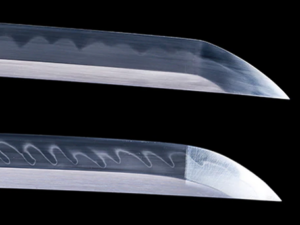The clay tempering or differential hardening of a katana blade results in a robust, fracture resistant blade with a soft and flexible back.
Clay Tempering / Differential Hardening of a Katana Blade
The fact that a katana is a single edged sword offers certain advantages. One of them is that the rest of the blade can be used to strengthen and support the cutting edge (hasaki). The Japanese way of making katana takes full advantage of this. When forging is complete, the steel is not hardened and quenched in the traditional European manner (i.e., evenly over the entire blade). In order to maximize both the cutting edge and the resilience of the back of the blade, a differential heat treatment technique is used.
In this specific process called clay tempering or differential hardening, the katana is painted with clay before being heated, creating a thin layer of clay on the edge. This ensures rapid cooling and thus maximum hardening of the cutting edge (hasaki). A thicker layer of clay is applied to the rest of the blade, resulting in slower cooling. This process creates a softer, more resilient steel that allows the katana to absorb impacts without breaking.
Sustainably sharp blade even under rough conditions such as combat.
This process has two side effects that are typical of Japanese katana:
- It leads to a curvature of the blade.
- It creates a visible boundary between hard and soft steel. This temper line is called “hamon”.
Hamon (Temper Line)
The Hamon 刃紋 (temper line or hardening pattern) is the visible outline of the yakiba (hardened part of the blade) and is used as a factor to assess both the quality and beauty of a blade. The different temper patterns of the hamon result from the way the clay is applied. The hamon can also serve as an indicator of the style of sword making or as a signature for the smith.

Summary
Clay tempering or differential hardening is both an art and a science. Traditional clay tempering techniques are perhaps the pinnacle of Japanese katana design, and today, clay tempering techniques are used by many modern smiths for swords and knives.
The goal of clay tempering is to achieve both hardness and flexibility in a blade.
The cutting edge of the blade (hasaki) is thus sharp, hard, and robust, while the back of the blade remains soft. Combining these two characteristics, hardness and flexibility, results in a magnificent Samurai Sword.



Katana from our shop:
Katana “Doragon no Hi”
Katana “Kogane no Doragon”
Katana “Mitsuri”
Katana “Roiyaru Tonbo”